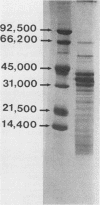Abstract
We studied seven strains of group G streptococci isolated from clinically severe bacteremic infections in six intravenous drug abusers. These group G strains multiplied luxuriantly in fresh human blood. On electron microscopy, they exhibited surface fibrillae similar to those observed in M-protein-rich group A streptococci, but they were not serologically M typable with a battery of 39 M antisera. Rabbit antisera raised against two of the group G strains (1618 and 1750) opsonized the homologous but not the heterologous isolates and exhibited type-specific Ouchterlony immunoprecipitin reactions. Moreover, antisera raised against peptic extracts of strain 1750 also promoted phagocytic killing of that strain. Anti-1750 reacted in high titer in an enzyme-linked immunosorbent assay against peptic extracts of the homologous strain; these antibodies were removed by absorption with 1750 cells but not by absorption with heterologous strains. These studies represent, to our knowledge, the first analysis of virulence factors of group G streptococci isolated from invasive human disease. The seven epidemiologically related blood isolates of group G streptococci possess distinct type-specific, antiphagocytic surface virulence factors analogous to the M proteins of group A streptococci.
Full text
PDF




Images in this article
Selected References
These references are in PubMed. This may not be the complete list of references from this article.
- Auckenthaler R., Hermans P. E., Washington J. A., 2nd Group G streptococcal bacteremia: clinical study and review of the literature. Rev Infect Dis. 1983 Mar-Apr;5(2):196–204. doi: 10.1093/clinids/5.2.196. [DOI] [PubMed] [Google Scholar]
- Beachey E. H., Campbell G. L., Ofek I. Peptic digestion of streptococcal M protein. II. Extraction of M antigen from group A streptococci with pepsin. Infect Immun. 1974 May;9(5):891–896. doi: 10.1128/iai.9.5.891-896.1974. [DOI] [PMC free article] [PubMed] [Google Scholar]
- Clark R. B., Berrafati J. F., Janda J. M., Bottone E. J. Biotyping and exoenzyme profiling as an aid in the differentiation of human from bovine group G streptococci. J Clin Microbiol. 1984 Oct;20(4):706–710. doi: 10.1128/jcm.20.4.706-710.1984. [DOI] [PMC free article] [PubMed] [Google Scholar]
- Craven D. E., Rixinger A. I., Bisno A. L., Goularte T. A., McCabe W. R. Bacteremia caused by group G streptococci in parenteral drug abusers: epidemiological and clinical aspects. J Infect Dis. 1986 May;153(5):988–992. doi: 10.1093/infdis/153.5.988. [DOI] [PubMed] [Google Scholar]
- Efstratiou A. The serotyping of hospital strains of streptococci belonging to Lancefield group C and group G. J Hyg (Lond) 1983 Feb;90(1):71–80. doi: 10.1017/s0022172400063865. [DOI] [PMC free article] [PubMed] [Google Scholar]
- Hill H. R., Caldwell G. G., Wilson E., Hager D., Zimmerman R. A. Epidemic of pharyngitis due to streptococci of Lancefield group G. Lancet. 1969 Aug 16;2(7616):371–374. doi: 10.1016/s0140-6736(69)92713-5. [DOI] [PubMed] [Google Scholar]
- Laemmli U. K. Cleavage of structural proteins during the assembly of the head of bacteriophage T4. Nature. 1970 Aug 15;227(5259):680–685. doi: 10.1038/227680a0. [DOI] [PubMed] [Google Scholar]
- Lam K., Bayer A. S. Serious infections due to group G streptoccocci. Report of 15 cases with in vitro-in vivo correlations. Am J Med. 1983 Oct;75(4):561–570. doi: 10.1016/0002-9343(83)90434-5. [DOI] [PubMed] [Google Scholar]
- Lawal S. F., Coker A. O., Solanke E. O., Ogunbi O. Serotypes among Lancefield-group G streptococci isolated in Nigeria. J Med Microbiol. 1982 Feb;15(1):123–125. doi: 10.1099/00222615-15-1-123. [DOI] [PubMed] [Google Scholar]
- MOODY M. D., PADULA J., LIZANA D., HALL C. T. EPIDEMIOLOGIC CHARACTERIZATION OF GROUP A STREPTOCOCCI BY T-AGGLUTINATION AND M-PRECIPITATION TESTS IN THE PUBLIC HEALTH LABORATORY. Health Lab Sci. 1965 Jul;2:149–162. [PubMed] [Google Scholar]
- Maxted W. R., Potter E. V. The presence of type 12 M-protein antigen in group G streptococci. J Gen Microbiol. 1967 Oct;49(1):119–125. doi: 10.1099/00221287-49-1-119. [DOI] [PubMed] [Google Scholar]
- OUCHTERLONY O. Diffusion-in-gel methods for immunological analysis. II. Prog Allergy. 1962;6:30–154. doi: 10.1159/000313795. [DOI] [PubMed] [Google Scholar]
- STOLLERMAN G. H., KANTOR F. S., GORDON B. D. Accessory plasma factors involved in the bactericidal test for type-specific antibody to group A streptococci. I. A typical behavior of some human and rabbit bloods. J Exp Med. 1958 Oct 1;108(4):475–491. doi: 10.1084/jem.108.4.475. [DOI] [PMC free article] [PubMed] [Google Scholar]
- Scott J. R., Pulliam W. M., Hollingshead S. K., Fischetti V. A. Relationship of M protein genes in group A streptococci. Proc Natl Acad Sci U S A. 1985 Mar;82(6):1822–1826. doi: 10.1073/pnas.82.6.1822. [DOI] [PMC free article] [PubMed] [Google Scholar]
- Swanson J., Hsu K. C., Gotschlich E. C. Electron microscopic studies on streptococci. I. M antigen. J Exp Med. 1969 Nov 1;130(5):1063–1091. doi: 10.1084/jem.130.5.1063. [DOI] [PMC free article] [PubMed] [Google Scholar]
- Vartian C., Lerner P. I., Shlaes D. M., Gopalakrishna K. V. Infections due to Lancefield group G streptococci. Medicine (Baltimore) 1985 Mar;64(2):75–88. doi: 10.1097/00005792-198503000-00001. [DOI] [PubMed] [Google Scholar]
- Watsky K. L., Kollisch N., Densen P. Group G streptococcal bacteremia. The clinical experience at Boston University Medical Center and a critical review of the literature. Arch Intern Med. 1985 Jan;145(1):58–61. doi: 10.1001/archinte.145.1.58. [DOI] [PubMed] [Google Scholar]





